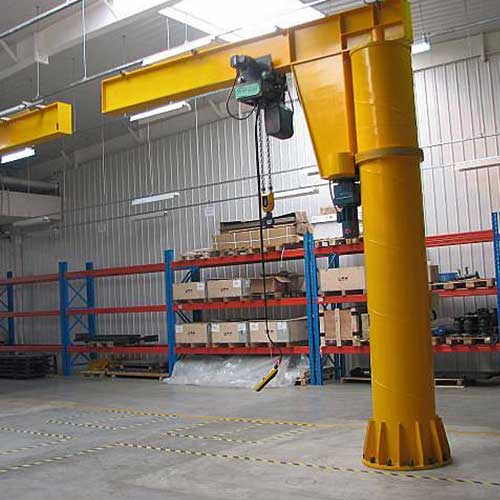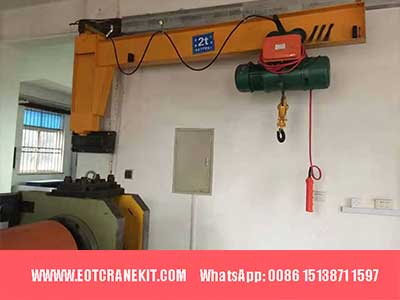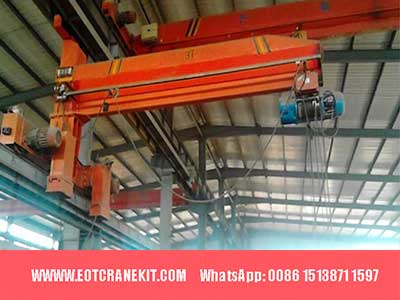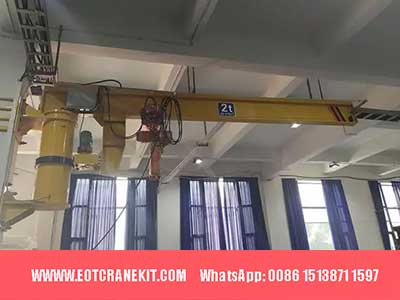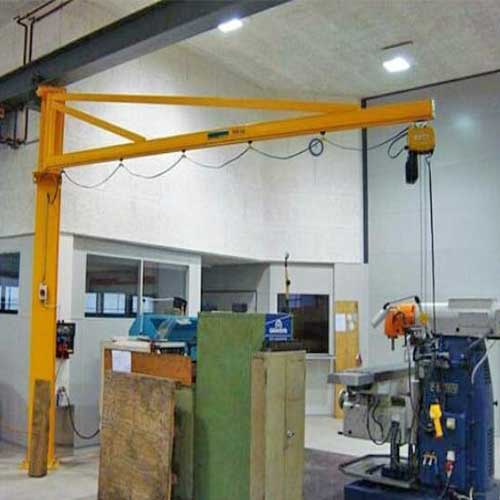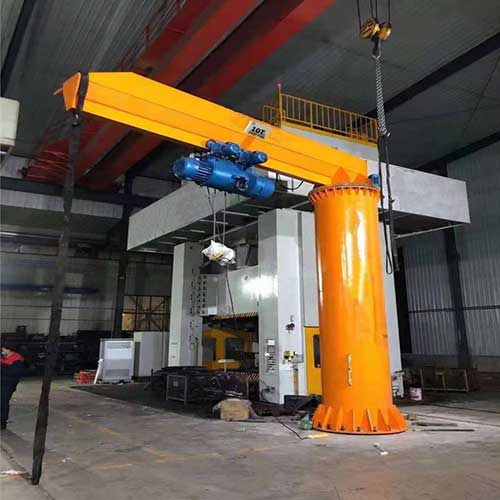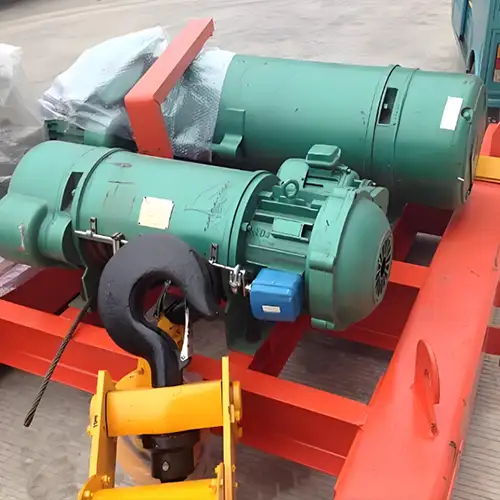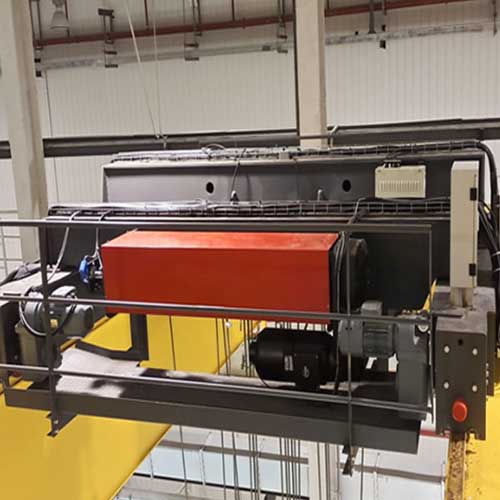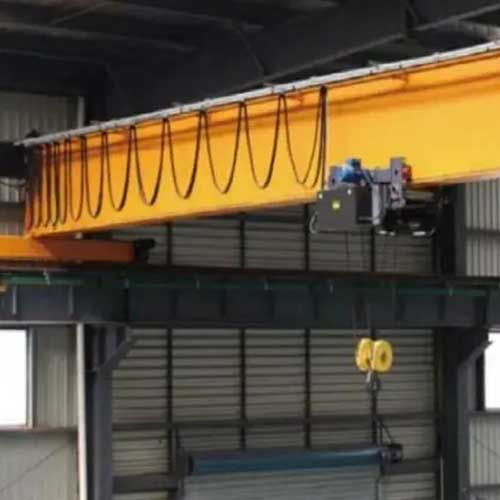Jib Crane and Hoist | Floor Jib Crane & Wall Jib Crane with Hoist
Jib Crane and Hoist for sale. All types of floor Jib cranes & wall jib crane with hoists, i.e, electric hoist / manual hoist. Jib Hoist Crane for Sale.
| JIb Hoist Type | Floor jib & Wall jib cranes with Hoists |
| Wall jib crane with hoist | 0.25- 5 ton |
| Floor jib crane with hoist | 0.5 ton - 16 ton |
| Jib arm | As customer requirement |
| Lifting height | As customer requirement |
Category: Overhead Hoist
Your Trusted Jib Crane and Hoist Crane Manufacturer & Supplier
Jib Crane and Hoist for Sale, Types of Floor Jib Cranes & Wall Jib Cranes with Hoists
Jib Crane and Hoist for sale. All types of floor Jib cranes & wall jib crane with hoists, i.e, electric hoist / manual hoist. Jib Hoist Crane for Sale.
Introduction to Jib Cranes and Hoists
Material handling and lifting tasks are at the core of various industries, from manufacturing and construction to warehouses and maintenance facilities. To accomplish these tasks efficiently and safely, the use of specialized equipment like jib cranes and hoists has become essential. This comprehensive guide aims to illuminate the world of jib cranes and hoists, exploring their diverse types, features, benefits, and applications.
Defining Jib Hoist Lifting Devices
Jib hoist lifting devices are indispensable tools designed to lift, move, and position heavy objects within a specified workspace. These versatile setups typically consist of several key components, including a vertical mast, a horizontal boom, a hoist mechanism, and optional accessories. Jib hoists provide a range of lifting solutions that cater to different industries and applications.
Jib Hoist for Sale: Finding the Right Fit
When searching for a jib hoist for sale, it's imperative to understand your specific requirements and the nuances of your lifting tasks. The market offers a plethora of options, each with its unique features and capabilities. To make an informed choice, consider factors such as load capacity, lifting height, power source (electric, manual, or pneumatic), and any specialized needs dictated by your industry.
Choosing the right jib hoist is a critical step in optimizing your material handling operations. A well-suited jib hoist can enhance productivity, improve safety, and ultimately save time and resources.
Jib Hoist Crane: A Seamless Lifting Solution
A jib hoist crane represents the perfect marriage of a jib crane and a hoist mechanism. This combination provides a seamless and efficient solution for lifting and moving heavy loads. The jib crane's horizontal boom, which can rotate to cover a specific area, is paired with a hoist that can easily lift objects vertically. This integration ensures precise load positioning and controlled movement, making it an invaluable asset in a variety of industries.
Key Features of Jib Hoists
Jib hoists come equipped with a host of features that contribute to their effectiveness:
- Electric or Manual Operation: Depending on your needs and preferences, jib hoists can be powered electrically or operated manually, offering versatility in their use.
- Variable Lifting Capacities: Jib hoists come in various capacities, ranging from modest loads to heavy-duty lifting, making them suitable for a wide range of applications.
- Ergonomic Controls: Modern jib hoists often feature user-friendly controls, such as pendant or remote systems, allowing operators to manage the lifting process with precision.
- Safety Features: Safety is paramount in material handling. Jib hoists are equipped with features like overload protection and emergency stops, ensuring safe and secure operations.
The Versatility of Jib Hoists
One of the most striking characteristics of jib hoists is their adaptability to diverse work environments. Their compact design and flexibility make them suitable for a multitude of tasks. From loading and unloading materials in warehouses to serving in machine shop operations or assisting in construction projects, jib hoists can easily fit into various scenarios, enhancing productivity and efficiency.
In the subsequent sections, we will explore the world of jib cranes, including their types, components, and applications. We will also provide insights into selecting the right equipment, ensuring safety during operations and maintenance, and much more to empower you in your material handling endeavors.
Jib cranes are versatile lifting solutions with various configurations and features. In this section, we'll explore the world of jib cranes, including their types, components, and how they can enhance your material handling operations.
Types of Jib Cranes
Jib cranes, known for their versatility and efficiency, come in various types to cater to specific lifting needs. In this section, we'll explore two prominent types of jib cranes and understand how their integration with hoist mechanisms enhances their lifting capabilities.
Jib Crane with Hoist: A Powerful Combination
- The jib crane with hoist is a dynamic fusion of two essential lifting components—a jib crane and a hoist mechanism. This integration creates a powerhouse of lifting capabilities with several advantages:
- Precise Vertical Lifting: The hoist mechanism, whether electric, manual, or pneumatic, provides precise control over vertical lifting and lowering. This precision is invaluable in scenarios where loads must be positioned with accuracy, such as assembly processes or construction projects.
- Extended Reach: While a standard jib crane excels in providing horizontal reach within a defined workspace, the inclusion of a hoist extends its capabilities. The hoist enables the crane to lift loads vertically within its coverage area, making it exceptionally useful when materials need to be transferred from different elevations.
- Versatility in Load Handling: The jib crane with hoist can handle a wide range of load sizes and weights. Hoists are available in various capacities, allowing for the lifting of small components or substantial machinery. This versatility makes it a preferred choice in industries with diverse material handling requirements.
- Enhanced Productivity: The integration of a hoist mechanism streamlines material handling processes, leading to improved productivity. Tasks that would be time-consuming and labor-intensive when done manually can be completed efficiently with the assistance of a hoist. This can result in cost savings and faster project turnaround times.
- Improved Safety: Safety is paramount in material handling, and a jib crane with a hoist includes safety features such as overload protection and emergency stops. These features help ensure the safety of both operators and the loads being handled, reducing the risk of accidents or damage to materials.
- Reduced Operator Fatigue: Manual lifting of heavy objects can lead to operator fatigue and potential injuries. With a hoist mechanism, the physical strain on operators is significantly reduced. They can control the lifting process with ease, reducing the risk of strain-related injuries and fatigue.
- Adaptability to Various Environments: Jib cranes with hoists are adaptable to a wide range of work environments, from manufacturing facilities and construction sites to warehouses and assembly lines. Their compact design and versatility make them a valuable asset in industries with diverse material handling needs.
Jib Crane with Electric Hoist: An Electric Revolution
The jib crane with an electric hoist introduces a new level of efficiency and precision to material handling operations. Here's a closer look at the benefits of this electrically powered combination:
- Efficiency and Speed: Electric hoists are known for their efficiency and speed in lifting and positioning loads. They can handle heavy loads smoothly and quickly, reducing downtime and enhancing productivity.
- Precision and Control: Electric hoists offer precise control over load movement, allowing operators to position materials with utmost accuracy. This level of control is crucial in applications where precise placement is required.
- Reduced Operator Effort: Electric hoists significantly reduce the physical effort required from operators. This means less strain and fatigue, leading to improved safety and operator comfort.
- Suitability for Heavy Loads: Jib cranes with electric hoists are well-suited for lifting heavy and bulky loads. They excel in applications where substantial materials or equipment need to be maneuvered efficiently.
- Enhanced Safety: Electric hoists often come equipped with advanced safety features, such as overload protection and limit switches. These safety mechanisms ensure that operations are carried out securely and reliably.
- Quiet Operation: Electric hoists operate quietly compared to some other hoist types, making them suitable for environments where noise control is a consideration.
In summary, the integration of hoist mechanisms into jib cranes, whether through a standard hoist or an electric hoist, significantly enhances their lifting capabilities. These combinations offer precision, efficiency, versatility, and safety, making them valuable assets in various industries and applications where material handling is a critical component of operations.
Main Types of Wall Jib Crane with Hoists
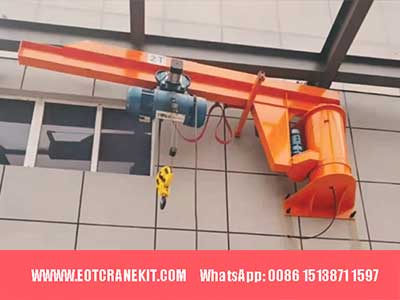
Fixed Wall Jib Crane with Hoist
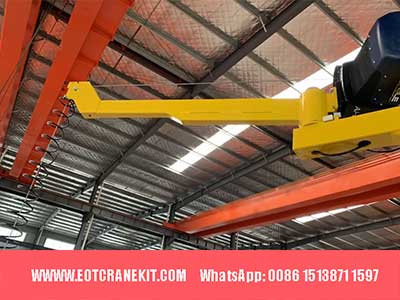
Articulating Wall Jib Crane with Hoist
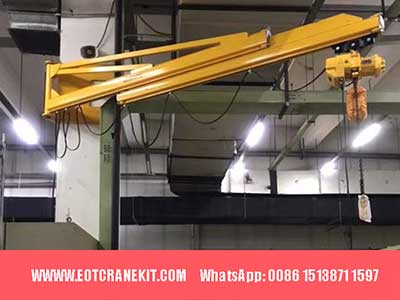
Telescoping Wall Jib Crane with Hoist
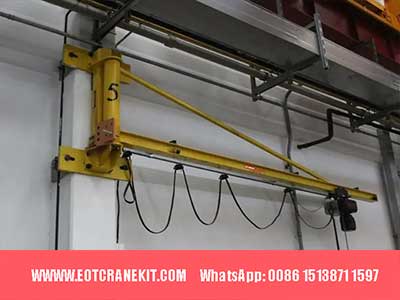
Foundation-Mounted Wall Jib Crane with Hoist
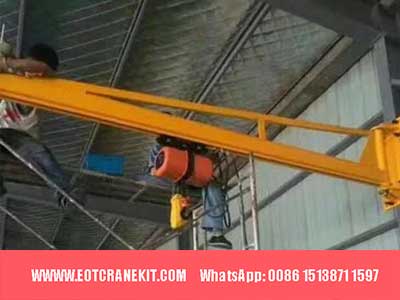
Explosion-Proof Wall Jib Crane with Hoist
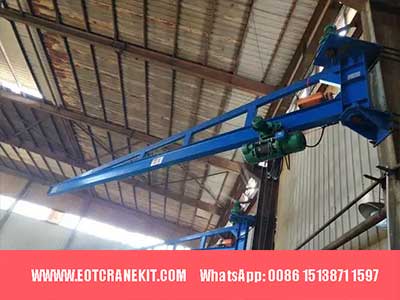
Corrosion-Resistant Wall Jib Crane with Hoist
Floor Jib Crane with Hoist
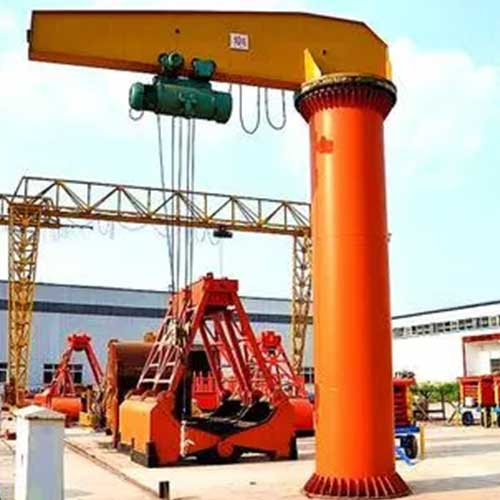
Heavy-Duty Floor Jib Crane and Hoist Crane
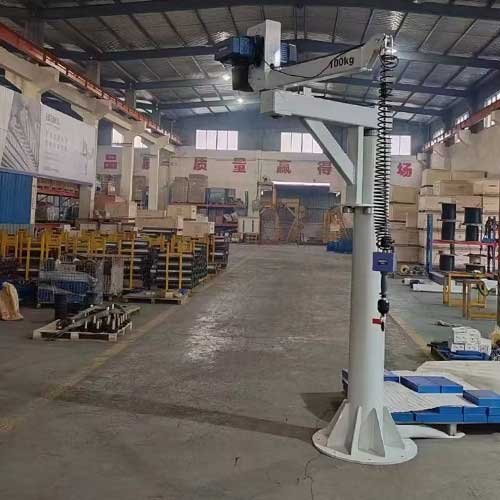
Articulating Cantilever Floor Jib Crane and Hoist Crane:
Jib Crane Load Management
Effective load management is at the core of efficient material handling operations. Jib cranes offer various solutions to streamline this process, ensuring that loads are handled with ease and precision. In this section, we will explore three crucial components that play a pivotal role in load management on jib cranes.
Jib Crane Winch: Effortless Load Management
A jib crane winch is a key component designed to simplify the process of handling heavy loads. Here's how it works:
- Mechanical Advantage: Winches operate on a drum and cable system, providing a mechanical advantage for lifting and lowering loads. This makes it easier for operators to manage heavy materials without excessive physical effort.
- Versatile Applications: Jib cranes equipped with winches find applications in various industries, from construction sites and shipyards to manufacturing facilities. They are especially valuable when dealing with oversized or cumbersome loads.
- Precise Load Control: Winches offer precise load control, allowing operators to lift, lower, or suspend loads at the desired height or position. This level of control is essential in tasks that require careful positioning of materials.
Jib Crane Trolley: Enhancing Mobility
- The jib crane trolley is a component that significantly improves load positioning and mobility along the jib arm. Here's how it enhances material handling:
- Horizontal Movement: Trolley systems on jib cranes enable horizontal movement along the length of the jib arm. This capability ensures that materials can be precisely placed at various points within the crane's working area.
- Versatility: Jib cranes with trolley systems are versatile and adaptable to a range of tasks. They excel in scenarios where loads need to be moved along a straight path horizontally while still benefiting from the jib crane's rotational reach.
- Efficiency: Trolley systems reduce the need for manual repositioning of the crane to access different areas, saving time and effort. This efficiency is valuable in environments where quick load adjustments are necessary.
Jib Crane Hoist Trolley: Precision at Your Fingertips
The jib crane hoist trolley takes load management to the next level by providing precise control over both vertical and horizontal movements. Here's why it's a valuable addition to jib cranes:
- Dual Control: Hoist trolleys offer operators the ability to control both the horizontal movement along the jib arm (similar to a standard trolley) and the vertical lifting and lowering of the load. This dual control ensures that loads can be maneuvered with exceptional precision and versatility.
- Delicate Handling: Hoist trolleys are ideal for applications that demand utmost precision and care in load handling. They excel in tasks involving the placement of delicate components or materials, such as in the aerospace industry or laboratories.
- Efficient Positioning: The combination of horizontal and vertical control makes hoist trolleys highly efficient for positioning loads precisely where they are needed. This reduces the risk of errors and minimizes the need for repositioning.
In summary, effective load management is a critical aspect of material handling, and jib cranes offer a range of solutions to optimize this process. Jib crane winches simplify the handling of heavy loads, trolley systems enhance mobility and positioning, and hoist trolleys provide a level of precision and versatility that is invaluable in tasks requiring delicate and efficient load management. These components play a vital role in improving productivity and safety in various industries where jib cranes are employed.
Jib Crane Components and Accessories
Jib cranes are efficient material handling solutions, and their effectiveness is greatly enhanced by a range of components and accessories. In this section, we'll delve into these vital elements that contribute to the functionality, safety, and customization of jib cranes.
Jib Crane Hoist: Lifting Made Easy
The jib crane hoist is at the heart of a jib crane, responsible for lifting and lowering heavy loads. Here's a closer look at its role and benefits:
- Core Lifting Mechanism: The hoist is the core lifting mechanism of a jib crane. It can be powered electrically, manually, or pneumatically, depending on the specific requirements of the application.
- Streamlined Material Handling: The hoist simplifies material handling by effortlessly lifting loads, reducing the physical strain on operators, and improving overall efficiency.
- Load Capacity: Jib crane hoists are available in various load capacities, allowing them to handle a wide range of materials, from lightweight components to heavy machinery.
Jib Crane Electric Hoist: Power Meets Precision
The jib crane electric hoist is a specialized type of hoist that brings a new level of power and precision to jib crane operations:
- Efficiency: Electric hoists are known for their efficiency in lifting and positioning loads. They can handle heavy materials smoothly and quickly, reducing downtime and enhancing productivity.
- Precision and Control: Electric hoists offer precise control over load movement, allowing operators to position materials with utmost accuracy. This is crucial in applications where precise placement is required.
- Reduced Operator Effort: Electric hoists significantly reduce the physical effort required from operators, enhancing safety and operator comfort.
Jib Crane Brake: Ensuring Safety
Safety is paramount in material handling operations. The jib crane brake is a critical component that ensures safe and reliable crane operation:
- Safety Features: Jib cranes are equipped with braking systems that prevent unintended movements and secure the load during operations. These features include emergency stops and overload protection.
- Reliability: Brakes contribute to the reliability of jib cranes, ensuring that loads remain stable and operators can work with confidence.
Jib Crane Beam: The Backbone of Stability
The jib crane beam serves as the structural foundation of the jib crane:
- Stability: The beam provides stability and support for the crane's arm and load. The design and strength of the beam are crucial factors to consider when selecting a jib crane to ensure it can handle the intended workload.
- Structural Integrity: A robust beam ensures the long-term structural integrity of the jib crane, allowing it to withstand heavy use and maintain its performance.
Jib Crane and Hoist Accessories: Customizing Your Setup
Accessories allow you to tailor your jib crane setup to specific tasks and environments:
- Versatility: Accessories such as specialized hooks, slings, and attachments increase the versatility of jib cranes, enabling them to handle a wide range of loads and materials.
- Customization: Customizable accessories ensure that your jib crane is optimized for your unique requirements, whether you're working in a manufacturing facility, warehouse, or construction site.
- Enhanced Efficiency: Well-chosen accessories can streamline material handling processes, improving efficiency and productivity.
In conclusion, the components and accessories of jib cranes play pivotal roles in enhancing their functionality, safety, and customization. Whether it's the core hoist mechanism, electric hoists, brakes, beams, or customizable accessories, each element contributes to the overall efficiency and effectiveness of jib cranes in various industrial and material handling applications.
Exploring Diverse Applications of Jib Cranes and Hoists
Jib cranes and hoists are versatile lifting solutions that find applications across various industries and environments. In this section, we'll delve into the wide-ranging practical uses of these dynamic lifting systems.
Hoist Jib Crane
The hoist jib crane combines the flexibility of a jib crane with the lifting power of a hoist. Its applications include:
- Materials Handling: Hoist jib cranes are ideal for efficiently moving materials within a defined workspace. They provide precise vertical and horizontal lifting capabilities, making them valuable in manufacturing and assembly processes.
- Loading and Unloading: These cranes excel in loading and unloading heavy materials onto trucks or workstations. Their compact design allows them to access tight spaces, increasing loading efficiency.
- Maintenance Tasks: Hoist jib cranes are commonly used in maintenance and repair operations, enabling technicians to lift and position equipment for servicing.
Hoist Jib: A Compact Lifting Solution
Hoist jibs are compact, standalone lifting solutions often employed in smaller work areas:
- Workbench Lifting: They are well-suited for lifting materials onto workbenches, making them valuable in machine shops and workshops.
- Assembly Stations: Hoist jibs assist in the assembly of products by providing precise load positioning and vertical lifting capabilities.
- Retail and Warehousing: They find use in retail settings and warehouses for managing inventory and handling goods.
Jib Cranes in Warehouses and Factories
Jib cranes play vital roles in warehouses and factories:
- Material Transport: Jib cranes facilitate the movement of goods within warehouses, reducing the need for manual labor and increasing efficiency.
- Loading and Unloading: They expedite the loading and unloading of materials, ensuring smooth logistics operations.
- Assembly Lines: Jib cranes are often integrated into assembly lines for precise component positioning and handling.
Jib Cranes on Construction Sites
Construction sites benefit from the mobility and lifting capabilities of jib cranes:
- Heavy Materials: Jib cranes efficiently lift heavy construction materials, aiding in building construction and infrastructure development.
- Equipment Erection: They are used for erecting structural components and positioning heavy equipment.
- Versatility: Their adaptability to changing site conditions makes them valuable tools for construction projects.
Jib Cranes in Manufacturing Processes
Jib cranes are integral to manufacturing processes across industries:
- Automotive: They assist in the assembly of vehicles, helping position components accurately.
- Aerospace: Jib cranes are used to handle delicate aircraft parts and ensure precise assembly.
- Textiles: In textile manufacturing, jib cranes transport materials and assist in maintenance.
Jib Cranes for Maintenance and Repairs
Maintenance and repair tasks benefit from the maneuverability and precision of jib cranes:
- Equipment Servicing: Jib cranes lift machinery and equipment for inspection and repairs.
- Facility Maintenance: They assist in maintaining facilities by enabling access to elevated areas and hard-to-reach locations.
- Safety Enhancements: Jib cranes improve workplace safety during maintenance operations.
Jib Cranes in Machine Shop Operations
Machine shops rely on jib cranes for various functions:
- Material Handling: Jib cranes are used to move heavy materials to and from machining centers.
- Tool Changes: They assist in changing and positioning tools for machining processes.
- Workspace Optimization: Jib cranes optimize shop layouts, improving efficiency and workspace organization.
In summary, jib cranes and hoists are indispensable tools in a wide range of applications, from manufacturing and construction to maintenance and warehousing. Their adaptability, precision, and efficiency make them essential assets in industries where material handling, lifting, and positioning are critical components of daily operations.
Choosing the Perfect Jib Crane and Hoist
Selecting the right jib crane and hoist is crucial to ensure optimal performance and safety in your material handling operations. In this section, we'll explore the essential factors to consider when making these critical decisions.
Factors to Consider When Choosing a Jib Crane
Selecting the ideal jib crane involves evaluating several key factors:
- Load Capacity: Determine the maximum weight you need to lift. Choose a jib crane with a load capacity that comfortably exceeds your requirements to account for potential future needs.
- Span and Reach: Consider the horizontal reach and rotational span of the crane. Ensure it covers the entire workspace or area where you'll be handling materials.
- Lift Height: Assess the vertical lifting needs of your application. Choose a jib crane that provides adequate lift height to position loads precisely.
- Type of Jib Crane: Decide between freestanding, wall-mounted, or ceiling-mounted jib cranes based on your available space and structural requirements.
- Hoist Type: Determine whether you need a manual, electric, or pneumatic hoist based on load weight, frequency of use, and precision requirements.
- Duty Cycle: Consider how often the crane will be in operation. Select a jib crane with an appropriate duty cycle rating to ensure longevity.
- Safety Features: Look for safety features such as overload protection, emergency stops, and limit switches to guarantee safe operation.
- Environmental Conditions: Assess the environment where the crane will be used. Ensure it is suitable for indoor or outdoor use and can withstand any harsh conditions.
- Ease of Maintenance: Choose a crane that is easy to maintain, with readily available replacement parts and accessible service points.
Factors to Consider When Choosing a Jib Hoist
Selecting the right jib hoist is equally critical to match your lifting needs:
- Hoist Capacity: Ensure the hoist's capacity aligns with the maximum load weight you anticipate lifting.
- Lifting Speed: Evaluate the required lifting speed for your application. Different hoists offer varying lifting speeds, so choose one that meets your productivity goals.
- Control Options: Consider the type of controls you prefer, whether pendant control, remote control, or a control panel integrated into the hoist.
- Precision Requirements: If precise load positioning is essential, opt for a hoist that provides fine control and accuracy.
- Duty Cycle: Determine how frequently the hoist will be in use and select a hoist with an appropriate duty cycle rating.
- Environmental Compatibility: Ensure that the hoist can operate safely in the environmental conditions of your workspace, including temperature, humidity, and dust levels.
Customization Options for Your Specific Needs
Many jib cranes and hoists offer customization options to tailor them to your unique requirements:
- Hook Configurations: Customized hooks or attachments can be added to accommodate specific load shapes or sizes.
- Trolley Systems: You can choose between manual or motorized trolley systems, depending on your load positioning needs.
- Accessories: Explore accessory options such as load balancers, load limiters, or specialized attachments to enhance the functionality of your crane and hoist.
- Paint and Finish: Customize the paint color and finish to match your workspace aesthetics or enhance visibility for safety.
Budget Considerations and Long-Term Benefits
While budget constraints are important, it's essential to focus on the long-term benefits of your jib crane and hoist investment:
- Total Cost of Ownership: Consider not only the initial purchase price but also ongoing operating costs, maintenance expenses, and potential energy savings.
- ROI: Evaluate the return on investment (ROI) your jib crane and hoist will provide in terms of increased productivity, safety improvements, and reduced labor costs.
- Warranty and Support: Research the warranty and customer support offered by the manufacturer to ensure reliability and timely assistance in case of issues.
- Life Expectancy: Choose quality equipment with a longer life expectancy to reduce the frequency of replacements and associated costs.
In conclusion, selecting the right jib crane and hoist requires a comprehensive assessment of your specific lifting needs, workspace conditions, and budget considerations. By carefully evaluating these factors and exploring customization options, you can make an informed decision that ensures optimal performance, safety, and long-term benefits for your material handling operations.
Prioritizing Safety and Maintenance in Jib Crane and Hoist Operations
Safety and maintenance are paramount when it comes to the operation of jib cranes and hoists. In this section, we'll delve into essential guidelines for ensuring the safety of personnel and equipment, as well as maintenance practices to extend the lifespan of your equipment. Additionally, we'll address common issues and troubleshooting tips.
Ensuring Safety During Jib Crane and Hoist Operations
Safety is non-negotiable in material handling operations involving jib cranes and hoists. Follow these measures to guarantee a secure working environment:
- Operator Training: Ensure that operators are trained and certified to operate jib cranes and hoists safely. They should be well-versed in the equipment's controls, safety features, and emergency procedures.
- Regular Inspections: Conduct routine inspections of your jib crane and hoist systems to identify any signs of wear, damage, or malfunction. Address issues promptly to prevent accidents.
- Load Limits: Always adhere to load capacity limits specified by the manufacturer. Overloading can lead to equipment failure and pose a significant safety risk.
- Clear Work Zones: Maintain clear work areas around jib cranes and hoists to prevent accidents caused by collisions with materials, structures, or personnel.
- Emergency Stops: Ensure that emergency stop buttons or switches are easily accessible and functional. They should be tested regularly.
- Safety Features: Familiarize yourself with the safety features of your jib crane and hoist, including overload protection, limit switches, and brake systems. Regularly check and test these features.
- Proper Rigging: Use appropriate rigging equipment and techniques when attaching loads to the hoist. Ensure that the load is securely fastened to prevent slippage.
- Personnel Clearances: Maintain safe distances between personnel and operating equipment to prevent accidents caused by swinging loads or moving equipment.
- Fall Protection: When working at heights, ensure that personnel wear appropriate fall protection equipment, such as harnesses and lanyards, if required.
Maintenance Tips for Extended Lifespan
Proper maintenance is essential to maximize the lifespan and reliability of jib cranes and hoists:
- Regular Lubrication: Follow the manufacturer's guidelines for lubricating moving parts to reduce friction and wear.
- Visual Inspections: Perform visual inspections before each use to check for loose bolts, damaged components, or signs of wear.
- Scheduled Maintenance: Implement a scheduled maintenance program that includes tasks such as checking electrical connections, inspecting wire ropes, and verifying safety features.
- Cleanliness: Keep your equipment clean by removing dirt, dust, and debris. Clean equipment operates more efficiently and has a longer lifespan.
- Documentation: Maintain detailed records of maintenance activities, including dates, tasks performed, and any issues identified. This documentation helps track the equipment's condition over time.
- Professional Inspections: Periodically, have your jib crane and hoist systems inspected by qualified professionals who can identify and address potential issues.
- Replacement of Worn Parts: When components show signs of wear, replace them promptly to prevent equipment failure.
Troubleshooting Common Jib Crane and Hoist Issues
Address common issues promptly to minimize downtime and ensure safe operation:
- Overloads: If the hoist experiences an overload, immediately lower the load and inspect for any damage. Determine the cause of the overload and take corrective action.
- Electrical Malfunctions: In the event of electrical issues, such as a loss of power or malfunctioning controls, consult the equipment's manual for troubleshooting steps. If unsure, contact a qualified electrician.
- Brake Failure: If the brake system fails, stop using the equipment immediately and have the brake system repaired or replaced by a qualified technician.
- Load Swinging: To prevent loads from swinging excessively, use slow and controlled movements when lifting or lowering materials.
- Strange Noises: Unusual noises from the hoist or crane may indicate mechanical problems. Investigate the source of the noise and address it promptly to prevent further damage.
In summary, safety and maintenance are integral to the successful operation and longevity of jib cranes and hoists. By prioritizing safety measures, implementing regular maintenance routines, and addressing issues promptly, you can ensure the well-being of personnel and the reliability of your equipment, ultimately contributing to a safe and efficient work environment.
Conclusion: Elevate Your Material Handling
In this comprehensive guide to jib cranes and hoists, we've explored the versatile world of lifting solutions, their applications, and the crucial factors to consider when selecting, operating, and maintaining them. Let's recap the key points covered and take a glimpse into future trends in the realm of jib cranes and hoists.
- Introduction to Jib Cranes and Hoists: We began by defining jib hoist lifting devices and understanding their significance, especially in material handling. We explored their diverse applications, from construction sites to manufacturing processes.
- Understanding Jib Hoists: We delved deeper into jib hoists, discovering how they serve as compact lifting solutions. We explored their key features and versatility in various industries.
- Exploring Jib Cranes: We took a closer look at jib cranes, categorizing them into different types and understanding their components and accessories. From hoist trolleys to electric hoists, we explored how these components enhance load management and overall crane functionality.
- Applications of Jib Cranes and Hoists: We examined the wide-ranging applications of jib cranes and hoists, from material handling in warehouses to precision work in machine shops. Their adaptability makes them indispensable across industries.
- Selecting the Right Jib Crane and Hoist: We discussed critical factors to consider when choosing the ideal jib crane and hoist, emphasizing the importance of load capacity, workspace requirements, and customization options.
- Safety and Maintenance: Ensuring safety during jib crane and hoist operations was a central theme. We outlined essential safety measures and provided maintenance tips to extend the equipment's lifespan. Additionally, we addressed common troubleshooting issues.
Future Trends in Jib Cranes and Hoists
As technology advances and industry needs evolve, several trends are expected to shape the future of jib cranes and hoists:
- Automation: The integration of automation and robotics into material handling processes is likely to increase. Jib cranes and hoists may become more seamlessly integrated into automated workflows.
- Digitalization: The use of sensors, data analytics, and remote monitoring is expected to enhance equipment performance, providing predictive maintenance capabilities and real-time insights.
- Sustainability: Energy-efficient and eco-friendly designs will gain prominence as industries prioritize sustainability and reduced environmental impact.
- Ergonomics: Future jib cranes and hoists may place greater emphasis on operator ergonomics, enhancing comfort and safety during prolonged use.
- Customization: Customization options will expand, allowing businesses to tailor their jib crane and hoist setups to unique tasks and environments.
- Safety Innovations: Continued advancements in safety features, such as collision avoidance systems and enhanced load monitoring, will further reduce the risk of accidents.
In conclusion, jib cranes and hoists play a pivotal role in material handling across industries. By understanding their types, applications, and the factors influencing their selection, as well as prioritizing safety and maintenance, businesses can elevate their material handling capabilities and maintain efficient and secure operations. As we look to the future, technology-driven trends will likely further enhance the versatility and efficiency of these indispensable lifting solutions.
Related Products

Latest project
150 Ton Overhead Crane Installation Feedback – Paraguay Case
QDX 150 ton overhead crane in action in Paraguay. Installation photos, video, and client feedback show performance, safety, and heavy-lifting efficiency.
Free consultation to Confirm Parameters & Specifications and Get
Latest Crane Price & Crane Rate.
- Types of overhead cranes : _______?
- Optional: Overhead travelling crane, goliath gantry crane,Slewing jib crane, Single girder or double girder crane,small portable crane or kbk crane, etc.
- Capacity of overhead crane: _______?
- Optional: 0.25ton, 0.5 ton, 1 ton, 2 ton, 3ton, 5 ton, 10 ton,15ton, 20ton, 25 ton, 30ton,35ton, up to 550ton, etc.
- Crane span & lifting height : _______?
- Crane travelling length : _____?
- Control of overhead crane:_______?
- Optional: pendant/ remote/cabin control
- Voltage supply of overhead crane:_____?
- Eg,: 380V50/60HZ,3Phase or others,etc.
- Application/usage of crane:_______?
- Eg,: Steel mill, ,injection mold, cement,stone, concrete,granite, general manufacturing, etc.
Just leave a message via the contact form and our hoist and crane engineer will contact you with in 24working hours.
Get In Touch
